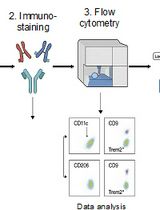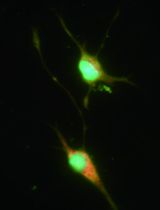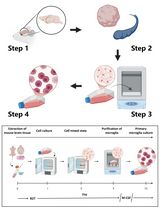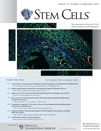- Submit a Protocol
- Receive Our Alerts
- Log in
- /
- Sign up
- My Bio Page
- Edit My Profile
- Change Password
- Log Out
- EN
- EN - English
- CN - 中文
- Protocols
- Articles and Issues
- For Authors
- About
- Become a Reviewer
- EN - English
- CN - 中文
- Home
- Protocols
- Articles and Issues
- For Authors
- About
- Become a Reviewer
Isolation and Primary Culture of Adult Mouse Cardiac Fibroblasts
Published: Vol 6, Iss 13, Jul 5, 2016 DOI: 10.21769/BioProtoc.1860 Views: 19454
Reviewed by: Jingli CaoAnonymous reviewer(s)

Protocol Collections
Comprehensive collections of detailed, peer-reviewed protocols focusing on specific topics
Related protocols

Identification and Sorting of Adipose Inflammatory and Metabolically Activated Macrophages in Diet-Induced Obesity
Dan Wu [...] Weidong Wang
Oct 20, 2025 2126 Views

Selective Enrichment and Identification of Cerebrospinal Fluid-Contacting Neurons In Vitro via PKD2L1 Promoter-Driven Lentiviral System
Wei Tan [...] Qing Li
Nov 20, 2025 1269 Views

Revisiting Primary Microglia Isolation Protocol: An Improved Method for Microglia Extraction
Jianwei Li [...] Guohui Lu
Dec 5, 2025 1175 Views
Abstract
Fibroblasts are often used as a feeder layer for progenitor or stem cells in co-culture systems. In the heart fibroblasts are important for cardiac development, homeostasis, and remodelling. They provide cardiomyocytes and progenitor cells not only with nutrition but also secrete extracellular matrix that forms the microenvironment that ensures cell survival and function. Although different kinds of mouse fibroblasts have been used in co-cultures (embryonic, skin and cardiac fibroblasts) adult mouse cardiac fibroblasts (AMCFs) create the closest microenvironment to the adult murine heart for culturing adult mouse cardiac progenitor cells. This protocol describes the isolation of cardiac fibroblasts from adult mouse hearts as well as their maintenance in culture.
Materials and Reagents
- Falcon tubes (50 ml) (Sarsdtedt)
- Sterile pipets (Sarsdtedt)
- 100 mm cell culture dishes (Sarsdtedt)
- Aluminum foil
- Adult mouse hearts from freshly euthanized mice (C57Bl6/J)
- NaCl (Carl Roth, catalog number: 3957.2 )
- KCl (Carl Roth, catalog number: HNO2.3 )
- Na2HPO4 (Carl Roth, catalog number: 4984.1 )
- KH2PO4 (AppliChem, catalog number: A2946 )
- CaCl2 (AppliChem, catalog number: A3652 )
- MgSO4.7H2O (AppliChem, catalog number: A1037 )
- NaHCO3 (AppliChem, catalog number: A1940 )
- Collagenase II (Worthington, catalog number: LS004177 )
- 2.5% Trypsin (Thermo Fisher Scientific, GibcoTM, catalog number: 15090-046 )
- DMEM/F12 (Thermo Fisher Scientific, GibcoTM, catalog number: 31331-028 )
- PBS (without CaCl2, MgCl2) (Thermo Fisher Scientific, GibcoTM, catalog number: 14190-94 )
- FBS (Thermo Fisher Scientific, GibcoTM, catalog number: 10270-106 )
- PenStrep (Thermo Fisher Scientific, GibcoTM, catalog number: 15140-122 )
- L-glutamine (Thermo Fisher Scientific, GibcoTM, catalog number: 25030-024 )
- Ascorbic acid (AppliChem, catalog number: A1052 )
- PBS (see Recipes)
- Hanks balanced salt solution (HBSS) (see Recipes)
- Collagenase II stock (see Recipes)
- Digestion buffer (see Recipes)
- Fibroblast medium (see Recipes)
Equipment
- Scalpel, forceps and scissors (Fine Science Tools)
- Autoclaved glass beaker (100 ml) with magnetic stirrer
- Sterile cell culture hood
- Cell culture incubator (Labotect Labor-Technik Göttingen)
- Magnetic stirrer with thermostat (IKA®-Werke GmbH & CO. KG)
- Cell culture centrifuge (Eppendorf, model: 5417R )
- Autoclave
Procedure
- Remove 3 adult mouse hearts from freshly euthanized mice and place them on a Petri dish containing ice cold PBS.
- Place the hearts under a sterile cell culture hood and perform the following steps under sterile conditions.
- Pump the blood out of the hearts by the use of forceps.
- Mince the 3 hearts on a Petri dish on ice. By the use of scissors cut the heart into 10 pieces and by the use of a scalpel reduce them into a size of 1 mm.
- Transfer the minced tissue (using the scalpel as a spatula) in an autoclaved glass beaker with a magnetic stirrer and cover the beaker with aluminum foil.
- Add 25 ml digestion buffer and digest tissue under constant stirring at 37 °C for 5 min.
Note: The stirring speed should be adjusted so that all the pieces of tissue just flow and do not sit at the bottom but should not be too strong to destroy the cells. - Leave the mixture for 1 min for the tissue to sit down and discard the first supernatant that contains debris and blood cells.
- Add 25 ml digestion buffer and digest tissue under constant stirring at 37 °C for 10 min.
- Leave the mixture 1 min for the tissue to sit down and collect the supernatant with a 25 ml pipette (around 22 ml). Do not collect the tissue pieces that tend to float.
- Place the supernatants in plastic 50 ml falcon tubes on ice containing 2 ml fibroblast medium. If possible supernatants can be combined in one falcon but for each supernatant 2 ml of fibroblast medium is required.
- Repeat steps 6-10 until all the tissue is dissolved (typically 7-10 times).
- Spin the cells down for 5 min at 300 x g at 4 °C.
- Resuspend cells in 20 ml fibroblast medium.
- Plate the cell suspension into two 100 mm cell culture dishes (10 ml cell suspension/dish) and incubate them at 37 °C in a cell culture incubator with 5% CO2 for 2 h (“Pre-plating”).
- 2 h upon plating alive and healthy fibroblasts should have adhered to the dish. Check the cell confluence under the microscope (it should be around 50%). At this point fibroblasts resemble little round dots.
- Collect and discard supernatant. Wash 3x with 2.5 ml warm PBS and replenish with 10 ml fresh fibroblast medium. Cultivate at 37 °C and 5% CO2 in a cell culture incubator.
- Primary adult mouse fibroblasts divide less than embryonic ones and under our culture conditions have a doubling time of 36-48 h. Typically, 2-3 days upon plating the fibroblasts reach 90% confluence.
Note: Caution! Do not split the fibroblasts until they reached a minimum confluence of 80% because the fibroblasts growth rate will decrease and they will differentiate. - Once confluence is reached fibroblasts are trypsinized as follows.
- Wash two times with 2 ml pre-warmed PBS and then add 2 ml warm trypsin. Incubate for 5 min at 37 °C, in a cell culture incubator. Control if fibroblasts detached from plate. If not prolong incubation until the cells detach.
- Neutralize trypsin by adding 7 ml pre-warmed fibroblast medium.
- To achieve a re-plating confluence of 30%, split 1:3 into 3 new 100 mm plates. Add 3 ml of fibroblast suspension in a plate containing 7 ml fresh and warm fibroblast medium (final volume/plate 10 ml)
Representative data
For representative photos and results please refer to Zafiriou et al. (2014).
Notes
Note that primary isolated cells as fibroblasts are differentiated when cultured for a long time period (more than 20 days) cease to divide (Bayreuther et al.,1988). Moreover, using cells from the same passage leads to better reproducibility. Therefore, we recommend using passage 4 fibroblasts for all co-culture experiments.
Recipes
- PBS, 1 L
Dissolve the following in 800 ml distilled H2O (dH2O)
8 g of NaCl
0.2 g of KCl
1.44 g of Na2HPO4
0.24 g of KH2PO4
Adjust pH to 7.4 with HCl, add dH2O to 1 L, sterilized by autoclaving - Hanks balanced salt solution (HBSS) (100 ml)
- Stock solution 1: 8.0 g NaCl, 0.4 g KCl in 100 ml dH2O
- Stock solution 2: 0.358 g Na2HPO4, 0.6 g KH2PO4 in 100 ml dH2O
- Stock solution 3: 0.72 g CaCl2 in 50 ml dH2O
- Stock solution 4: 1.23 g MgSO4.7H2O in 50 ml dH2O
- Stock solution 5: 0.35 g NaHCO3 in 10 ml dH2O
- HBSS buffer: 10 ml Solution 1, 1 ml Solution 2, 1 ml Solution 3, 86 ml dH2O, 1 ml Solution 4, 1 ml Solution 5 (0.137 M NaCl, 5.4 mM KCl, 0.25 mM Na2HPO4, 0.44 KH2PO4, 1.3 mM CaCl2, 1 mM MgSO4, 4.2 mM NaHCO3)
- Collagenase II stock (1 ml)
Weight the appropriate amount of collagenase (varies from lot to lot) to obtain 10,000 U and dissolve in 1 ml sterile water - Digestion buffer (100 ml)
95 ml HBSS buffer
1 ml collagenase II (final conc. 100 U/ml)
4 ml 2.5% Trypsin (final conc. 0.1%)
Filter sterilize
For optimal enzymatic activity always prepare fresh. - Fibroblast medium
DMEM/F12
10% FBS
100 U/ml PenStrep
1x L-glutamine
100 µM ascorbic acid
Filter sterilize the whole medium and keep at 4 °C
Acknowledgments
This protocol was adapted by methods described by Lafontant et al. (2006) and Ohkubo et al. (1997).
The HBSS recipe was retrieved from the internet site labrat.com (link: http://www.thelabrat.com/protocols/Hanks.shtml).
This work was supported by the Deutsche Forschungsgemeinschaft (ZE900/1-1; ZI708/7-1, 8-1, 10-1; SFB1002; exFLIII) and the German Center for Cardiovascular Research (DZHK).
References
- Bayreuther, K., Rodemann, H. P., Hommel, R., Dittmann, K., Albiez, M. and Francz, P. I. (1988). Human skin fibroblasts in vitro differentiate along a terminal cell lineage. Proc Natl Acad Sci U S A 85(14): 5112-5116.
- Lafontant, P. J., Burns, A. R., Donnachie, E., Haudek, S. B., Smith, C. W. and Entman, M. L. (2006). Oncostatin M differentially regulates CXC chemokines in mouse cardiac fibroblasts. Am J Physiol Cell Physiol 291(1): C18-26.
- Ohkubo, N., Matsubara, H., Nozawa, Y., Mori, Y., Murasawa, S., Kijima, K., Maruyama, K., Masaki, H., Tsutumi, Y., Shibazaki, Y., Iwasaka, T. and Inada, M. (1997). Angiotensin type 2 receptors are reexpressed by cardiac fibroblasts from failing myopathic hamster hearts and inhibit cell growth and fibrillar collagen metabolism. Circulation 96(11): 3954-3962.
- Zafiriou, M. P., Noack, C., Unsold, B., Didie, M., Pavlova, E., Fischer, H. J., Reichardt, H. M., Bergmann, M. W., El-Armouche, A., Zimmermann, W. H. and Zelarayan, L. C. (2014). Erythropoietin responsive cardiomyogenic cells contribute to heart repair post myocardial infarction. Stem Cells 32(9): 2480-2491.
Article Information
Copyright
© 2016 The Authors; exclusive licensee Bio-protocol LLC.
How to cite
Zafeiriou, M. P., Noack, C. and Zelarayan, L. C. (2016). Isolation and Primary Culture of Adult Mouse Cardiac Fibroblasts. Bio-protocol 6(13): e1860. DOI: 10.21769/BioProtoc.1860.
Category
Cell Biology > Cell isolation and culture > Cell isolation
Do you have any questions about this protocol?
Post your question to gather feedback from the community. We will also invite the authors of this article to respond.
Share
Bluesky
X
Copy link









